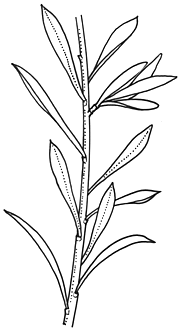Common name: Spreading Guinea Flower
Hibbertia procumbens (Labill.) DC. APNI* 
Description: Prostrate shrubs, sometimes mat-forming. Stems glabrous to pubescent with crisped hairs.
Leaves linear to narrow-oblanceolate or slightly falcate; 12–20 mm long, c. 2 mm wide; apex acute and often recurved, base attenuate-cuneate, ± sessile; margins often ciliate with crisped hairs; lamina glabrous or almost so, sometimes with glaucous bloom, upper surface usually concave and channelled. Midrib obscure on both surfaces, becoming more prominent towards the base on the lower surface.
Flowers terminal, sessile. Sepals 10–15 mm long, glabrous or often with ciliate margins. Petals 9–12 mm long, bright yellow. Stamens usually 20–25, surrounding carpels. Carpels generally 3, occasionally 4, glabrous.
Flowering: Flowers mostly in summer.
Distribution and occurrence: Rare in N.S.W., known from the Central Coast region near Somersby, Kulnura and Mangrove Mtn. Also occurs in Victoria and Tasmania. In heath on sandy soils.
NSW subdivisions: CC
Other Australian states: Vic. Tas.
Threatened species: NSW BCA: Endangered
Further investigation is required to determine whether plants in N.S.W. are the same species as those which occur in Victoria and Tasmania. See also VicFlora
Text by A.E. Orme (2021)
Taxon concept:
APNI* Provides a link to the Australian Plant Name Index (hosted by the Australian National Botanic Gardens) for comprehensive bibliographic data
***The AVH map option provides a detailed interactive Australia wide distribution map drawn from collections held by all major Australian herbaria participating in the Australian Virtual Herbarium project.
|


